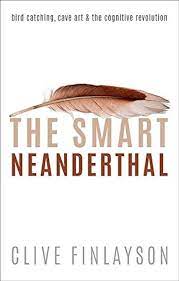The Smart Neanderthal: bird catching, cave art & the cognitive revolution
I am extremely interested in the Neanderthals, so I’ll read any book that gives me more information about them. I’ve already written a review of Kindred: Neanderthal Life, Love, Death and Art (post of February 24, 2022) and The Neanderthals Rediscovered (post of February 3, 2023).
I
recently read The Smart Neanderthal: Bird
catching, cave art & the cognitive revolution by Clive Finlayson, 2019,
and learned a fascinating aspect of the Neanderthals that I hadn’t read in
other books. The book is appropriate for the category Science for the 2024 Nonfiction Reader Challenge.
Finlayson
is a zoologist and a paleontologist, as well as the Director of the Gibraltar
Museum. This book is based on his excavations of Gorham’s Cave in Gibraltar,
which is believed to be the last known site of the Neanderthals. He explains
that his two scientific passions are the study of birds and of Neanderthals,
and his research shows that these two passions are closely connected.
Discoveries
about the Neanderthals in the last ten to twenty years have shown us that they
were intelligent, excellent tool makers and capable of art. They survived far
longer than modern humans have existed so far. However, many of the
misunderstandings about their abilities still influence many archaeologists. An
example is the belief that Neanderthals did not eat birds or use their feathers
because they were too slow or clumsy to be able to catch such fast, flying prey.
Finlayson’s research disproves this by studying the habits and characteristics
of the birds that existed in the time of the Neanderthals of Gorham’s Cave and
still exist today.
In
fact, Finlayson points out that many archaeologists make assumptions about
Neanderthals without knowing much about the flora and fauna they lived with. He
writes:
“In
interpreting the past and the abilities of our ancestors in the remove
Pleistocene we have not given due weight to the myriad interrelationships that
would have existed between humans and animals. We have focused our attention on
the study of archaeology and palaeoanthropology but we have not done natural
history. Our distant ancestors were the best natural historians that ever lived
and we will not understand them fully if we limit our research to the study of
skulls, stone tools, or butchery marks on bones. We have to understand them
from within by getting into the field and observing the animals which they also
saw and hunted, and in some cases probably revered. We will not find this out
by studying field guides or handbooks; we will only do it if we are prepared to
get muddy, frozen, or sun-baked as circumstances might dictate.”
And
he certainly has been prepared to get muddy and more. He focuses on birds, of
course because he already had a passion for studying them, but also because
“even though many of the mammal species that our ancestors saw are now extinct
and beyond our reach, the same is not the case with birds.” So his travels are
to places where these birds exist, and he studies their behavior to get an
insight into how the Neanderthals would have seen, hunted, eaten and made use
of them. This information is written like a travel journal, describing the
places Finlayson travelled to. But it doesn’t distract from the main
information.
The
beginning of Chapter 16 sums up Finlayson’s focus of the book very well:
“It’s
clear from what we have seen so far that the traditional techniques and methods
applied by archaeologists are insufficient when trying to answer questions
about some aspects of human behavior, especially when looking at a distant
past. We have already seen the benefits of a natural history approach. This approach,
in combination with taphonomic work, can really advance our understanding of
human behavior in the Pleistocene.”
Perhaps
the only weakness of the book is the final chapter, The Hashtag and the End of the Long Road to Neanderthal Emancipation,
in which he discusses the carving found in bedrock of Gorham’s Cave composed of
crossed lines that look like a “hashtag.” The section of the cave was clearly
used by Neanderthals, and the carving had been made by hand (not naturally). This indicates that it could be the first
example of cave art made by Neanderthals, who have been considered incapable of
such behavior. This is the “cave art” referred to in the book’s
title. However, most of the chapter describes the finding without much further
information confirming what it is. It seems like an afterthought to the book,
and has nothing to do with the book’s main ideas.
However,
I found most of the book to be fascinating. There is more about birds than
about the Neanderthals, but in total the book certainly supports Finlayson’s
hypothesis that Neanderthals hunted birds – and used them for more than food.


Comments
Post a Comment